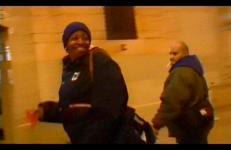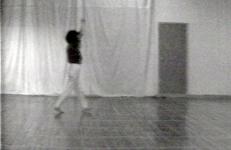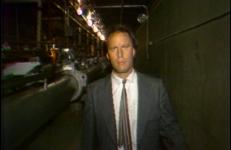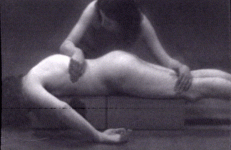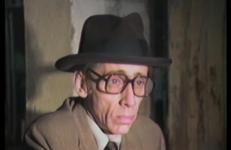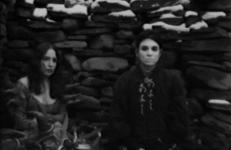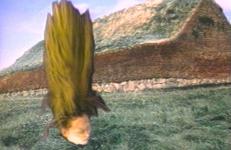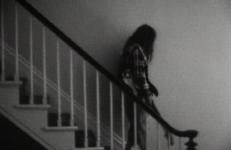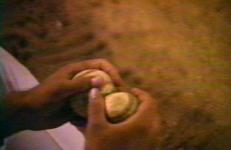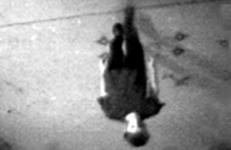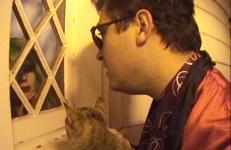My teaching assistant during the spring semester (Marc Rokoff) at the San Francisco Art Institute began shooting a documentary of me and the students making our sci-fi drama, The Planet of the Vamps. Three years later it remained unfinished as he felt inadequate as a documentarian, and so I was offered the box of tapes to edit. I took on the task and the result is a lively record of the production class in action as it tackles the teleplay with a minuscule budget and scanty costuming.
Performance
During my residency in New York I was designing a computer virus, which would contaminate computers through a screensaver that read “there is so much love in this world”. In the meanwhile, inspired by the illusionary democratic representation system in the United States and triggered by the indifference of the New York public to the presidential campaign, I went out to the streets to distribute fliers that carried this virus sentence. People of New York reacted in different ways to this action, which had similarities with many other hand-out actions common in big cities.
The first video work created collaboratively with DonChristian Jones as a part of Eiko's The Duet Project: Distance is Malleable. The video was projected as part of The Value of Sanctuary: Building a House Without Walls exhibition at The Cathedral of St. John the Divine in 2019.
Performed by Eiko Otake and DonChristian.
Camera by DonChristian Jones, Inci Eviner, Merián Soto.
Edited by Eiko Otake.
Created during the 2017 Rauschenberg Residency for The Duet Project.
The story of a matron and a midget in the heat of an unbridled passion. The colors run thick and heavy for paint and prurient pleasures as the electronic canvas unscrolls to reveal a bevy of beasties and beauties of nature and the unnatural. A non-stop melodrama of a patron of the arts shot by real art students in a real art school! A collaborative project I worked on with my class at the San Francisco Art Institute.
Executive Producer, Suzanne Lacy; Director, Steve Hirsch; Editor, Doug Gayeton.
From the performance Freeze Frame: Room for Living Room by Suzanne Lacy, Julia London, Ngoh Spencer, and Carol Leigh, San Francisco, 1982.
Adopting the movements of various animals, Forti begins the performance by walking hypnotically in circles. She falls to the floor and begins a cycle of walking and crawling that becomes an open metaphor for evolution and aging. Through the course of the performance, the camera follows Forti's circling motion at increasingly close range, creating an interactive dance between camera and performer. While "rustic" in respect to the quality of the video image and sound, Solo No. 1 serves as an engaging document of Forti's dedicated study of natural movement.
In these seven short video performances directed by Isaac Artenstein, Gómez-Peña confronts Mexican-American culture clashes, stereotypes, and the Fourth World (immigrants). Speaking through a bullhorn or on the airwaves of mock-station Radio Latino FM, he broadcasts a message that will not be silenced.
In these seven short video performances directed by Isaac Artenstein, Gómez-Peña confronts Mexican-American culture clashes, stereotypes, and the Fourth World (immigrants). Speaking through a bullhorn or on the airwaves of mock-station Radio Latino FM, he broadcasts a message that will not be silenced.
This collection of five shorts includes "These Are The Rules", a frightening incantation of "dos and don'ts" delivered by a red-faced fascist figure played by Hall. Each unique video "song" conveys and elicits a psychological space that is at times beautiful, and often disturbing. This tape also includes: "Fear of Falling", "Sounds of Glass", "Through the Room", and "Leaning Forward Carefully". "
Acconci literally feels the music in this tape as he lays down on speakers playing jazz. The sound pulses through his body while a collaborator massages his nude back in time with the music, occasionally striking Acconci like a rhythm instrument.
This title was in the original Castelli-Sonnabend video art collection.
Sounds in the Distance is a video adaptation of David Wojnarowicz's 1982 book Sounds in the Distance: Thirty-five Monologues from the Road.
Cast in order of appearance: Allen Frame, Tara Kelly, Nan Goldin, Kirsten Bates, Elisabeth Walker, Bill Rice, Brian Burchill, Suzanne Fletcher, Frank Franca.
Directed by Kirsten Bates and Allen Frame, Produced by Peggy Bates
A Japanese Kabuki-influenced performance piece, shot in the woods in Winter. A masked woman emerges from a snowy forest and approaches a stone dwelling, where another woman is waiting. The pair enact a tea ceremony in silence.
In the next scene the tea tray appears in the road, and then disappears after a car passes. Image processing magic.
Please note, production year is approximate.
“We lose good artists to the past all the time because their work was ephemeral, or difficult, or fashion wasn’t on their side. The performance artist Stuart Sherman, who died of AIDS in 2001, was a candidate for disappearance on all three counts.”
— New York Times, 2009
Sphinxes Without Secrets is an energetic and transgressive acount of outstanding female performance artists, and an invaluable document of feminist avant-garde work of the 70s and 80s. No Mona Lisa smiles here, as performance artists spill their guts about what outrages and delights them. Performers, curators, and critics unravel the mysteries of a new art form and ponder the world women confront today. Since its inception, performance art has provided a forum for artists who create work that challenges the dominant aesthetic and cultural status quo.
Patti Smith asked if I would do a short film to accompany the release of her version of Nirvana's Smells Like Teen Spirit. As neither of us are fans of the music video format or industry, we approached the project as a short film, with no lip sync, that would simply try to get at the heart of her version of the song. I shot in Super 8 film and pulled a few things from my archive. The film is a domestic portrait of Patti and her son, Jackson. William Blake was invited in the form of a plaster cast of his death mask.
Spit Sandwich is a compilation of 19 comical and entertaining works from the master of deadpan. Experiments with the video signal combine with visual jokes and one-liners to hilarious effect. Includes: II got . .Spit Sandwich is a compilation of 19 comical and entertaining works from the master of deadpan. Experiments with the video signal combine with visual jokes and one-liners to hilarious effect. Includes: II got . .
Thinking of herself as a spy assigned by the female sex, Green reinterprets baseball’s symbolism—its womblike landscape, its cycles and rituals—and constructs an iconography that pays homage to the female. In one magnificent montage, numerous phallic symbols pass by as Green sees the real purpose of the game: baseball is the only sport about returning home—and where is home...? In a mother’s belly. With humor and irony, Green creates a tape that is both a personal revelation and a heretical portrait.
From an inverted position, high above the floor, the camera records Nauman’s trek back and forth and across the studio; his stamping creates a generative rhythm reminiscent of native drum beats or primitive dance rituals. However, Nauman is not participating in a social rite or communal ritual—he is completely individualized. Isolated in his studio, his actions have no apparent reason or cause beyond his aesthetic practice.
This title was in the original Castelli-Sonnabend video art collection.
An All-American boy and girl are swept into an international intrigue of demonic content as items cursed with the stench of Satan make their way to a museum dedicated to the spiritual overthrow of family values. Loaded with romance, thrills, and exotic adventures, this electronic tele-play, with its colorful moments of scenic horror, leads the viewer on a fast-paced voyage that speeds through the ruins of Egypt, the jungles of equatorial erotica, and the puritanical Wonderland of Middle America.
Made with my students at the San Francisco Art Institute, this video drama explores the thrills and terrors of the Big Top as a travelling circus comes to town bringing with it the promise of cotton candy, eternal youth, and high-flying beefcake. A mother and son become enmeshed in a web of sin and sawdust, licorice and lust, as a town confronts its own hideous image in a maze of mirrors at a carnival of lost and found souls.
Male escorts and crytozoologists battle behemoths and bulemics in this student-teacher collaboration about undying evil and those that escape it via the LOVE CANAL.
... There is a garden in the dark hunger of his psyche where forbidden fruit grows.
— Mike Kuchar
Swamp Swamp and Wurmburth are each comprised of a series of tightly cropped shots of small, hand-made table-top sculptures or "sets". Paint and many other materials that behave like paint (i.e. lotion, shampoo, foodstuffs) are blown through these environments with plastic tubing and forced air. Each edited collection of shots makes an endless cycle of primal sludge and rupturing goo.
Taste the delicious colors of "SWEET NOTHINGS" and observe the dice of desire being tossed on a gambler’s bed like yesterday’s candy. See tomorrow’s chocolate bunny melt into a brown puddle and feel a sticky, rainbow colored lolly-pop thats stuck to six feet of skin that secrets pent up passions... It’s all here for you to eat and is guaranteed to fatten your eyes!!
Nancy Cain interviews an upside down chin face about Women's Liberation, asking "Where do you stand on the subject?" The chin face professes to be happy with her lot, and says she enjoys living alone with her cat.
This video was shot in the Prince Street, New York loft/studio used by the Videofreex.





